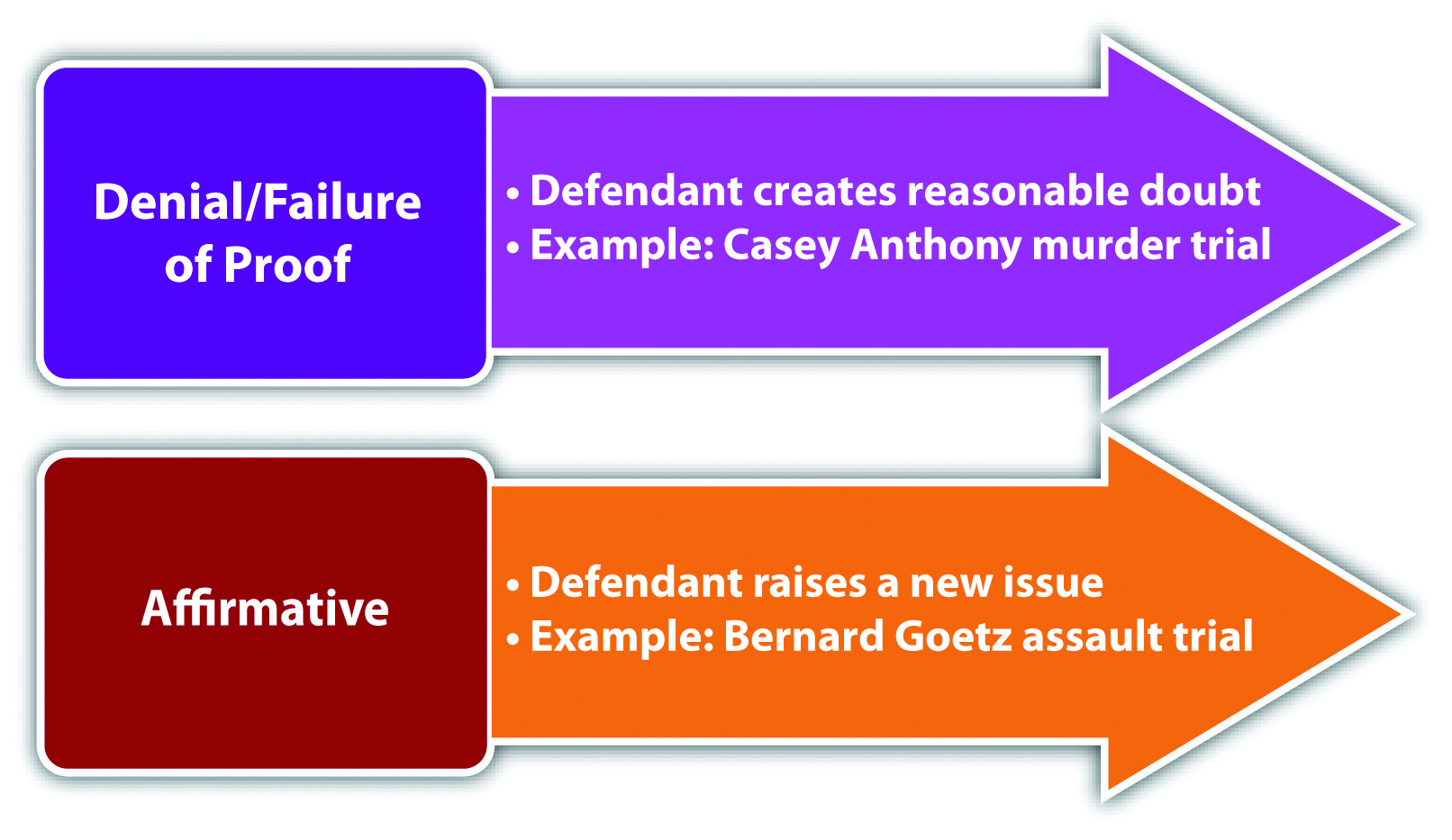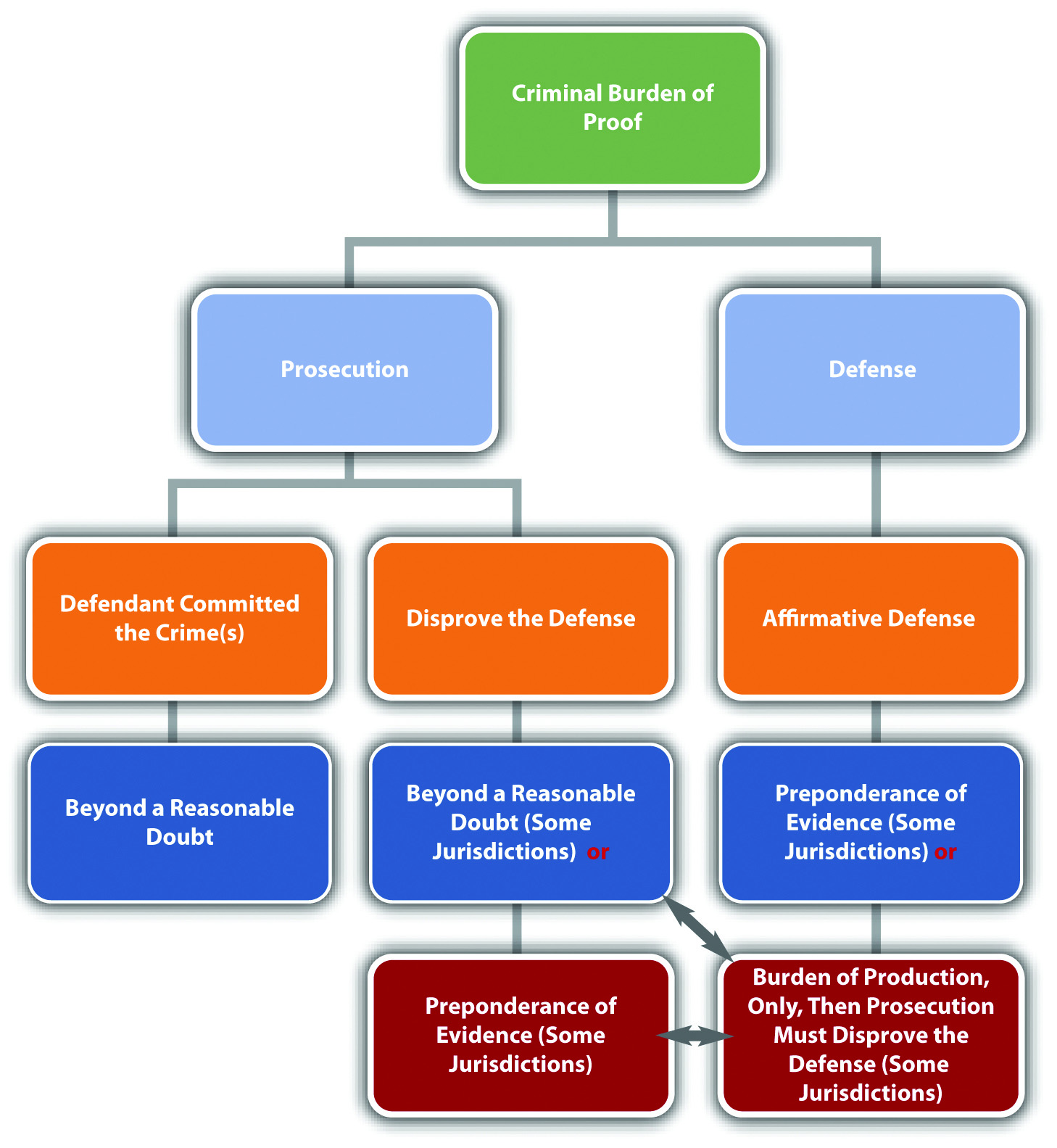
Daniel Hoherd – Broken Latch – CC BY-NC 2.0.
A person who unlawfully and by force enters or attempts to enter a person’s dwelling, residence, or occupied vehicle is presumed to be doing so with the intent to commit an unlawful act involving force or violence…
—Fla. Stat. Ann. §776.013(4), cited in Section 5.3.3 “Defense of Habitation”
Learning Objectives
- Distinguish between a denial or failure of proof defense and an affirmative defense.
- Distinguish between imperfect and perfect defenses.
- Distinguish between factual and legal defenses.
- Give examples of factual and legal defenses.
- Distinguish between defenses based on justification and excuse.
A plethora of criminal defenses exist. Defenses may completely exonerate the criminal defendant, resulting in an acquittal, or reduce the severity of the offense. Chapter 3 “Constitutional Protections” discussed defenses based on the federal Constitution. This chapter reviews the categorization of nonconstitutional criminal defenses, along with the elements of various defenses sanctioning the use of force.
Categorization of Defenses
Defenses can be categorized as denial or failure of proof, affirmative, imperfect, or perfect. Defenses can also be categorized as factual, legal, based on justification, or excuse. Lastly, defenses can be created by a court (common law), or created by a state or federal legislature (statutory).
Definition of Denial or Failure of Proof and Affirmative Defenses
As stated in Chapter 2 “The Legal System in the United States”, a criminal defendant will be acquitted if the prosecution cannot prove every element of the offense beyond a reasonable doubt. In certain cases, the defendant can either deny that a criminal element(s) exists or simply sit back and wait for the prosecution to fail in meeting its burden of proof. This legal strategy is sometimes referred to as either a denial or failure of proof defense.
An affirmative defense is not connected to the prosecution’s burden of proof. When the defendant asserts an affirmative defense, the defendant raises a new issue that must be proven to a certain evidentiary standard. State statutes often specify whether a defense is affirmative. The Model Penal Code defines an affirmative defense as a defense that is deemed affirmative in the Code or a separate statute, or that “involves a matter of excuse or justification peculiarly within the knowledge of the defendant” (Model Penal Code § 1.12 (3) (c)). Procedurally, the defendant must assert any affirmative defense before or during the trial, or the defense cannot be used as grounds for an appeal.
Example of an Affirmative Defense
A fight breaks out at a party, and Juan is severely injured. Jasmine and Jerome are arrested and charged for battering Juan. Jerome claims that he did not touch Juan; someone else battered him. Jasmine claims that she did not batter Juan because she was legally defending herself against Juan’s attack. Jerome’s claim focuses on the elements of battery and asserts that these elements cannot be proven beyond a reasonable doubt. Technically, Jerome can do nothing and be acquitted if the prosecution fails to prove that he was the criminal actor. Jasmine’s self-defense claim is an affirmative defense. Jasmine must do something to be acquitted: she must prove that Juan attacked her to a certain evidentiary standard.

Figure 5.1 Denial and Affirmative Defenses
Burden of Proof for Affirmative Defenses
As stated in Chapter 2 “The Legal System in the United States”, states vary as to their requirements for the defendant’s burden of proof when asserting an affirmative defense (Findlaw.com, 2010). Different defenses also have different burdens of proof. Some states require the defendant to meet the burden of production, but require the prosecution to thereafter meet the burden of persuasion, disproving the defense to a preponderance of evidence, or in some states, beyond a reasonable doubt. Other states require the defendant to meet the burden of production and the burden of persuasion. In such states, the defendant’s evidentiary standard is preponderance of evidence, not beyond a reasonable doubt. In the example given in Section 5 “Example of an Affirmative Defense”, for Jasmine’s self-defense claim, Jasmine must prove she was defending herself by meeting either the burden of production or the burden of production and persuasion to a preponderance of evidence, depending on the jurisdiction.

Figure 5.2 Diagram of the Criminal Burden of Proof
Definition of Imperfect and Perfect Defenses
As stated previously, a defense can reduce the severity of the offense, or completely exonerate the defendant from criminal responsibility. If a defense reduces the severity of the offense, it is called an imperfect defense. If a defense results in an acquittal, it is called a perfect defense. The difference between the two is significant. A defendant who is successful with an imperfect defense is still guilty of a crime; a defendant who is successful with a perfect defense is innocent.
Example of Imperfect and Perfect Defenses
LuLu flies into a rage and kills her sister Lola after she catches Lola sleeping with her fiancé. LuLu is thereafter charged with first-degree murder. LuLu decides to pursue two defenses. First, LuLu claims that the killing should be manslaughter rather than first-degree murder because she honestly but unreasonably believed Lola was going to attack her, so she thought she was acting in self-defense. Second, LuLu claims she was insane at the time the killing occurred. The claim of manslaughter is an imperfect defense that will reduce LuLu’s sentence, but will not acquit her of criminal homicide. The claim of insanity is a perfect defense that will result in an acquittal.
Definition of Factual and Legal Defenses
A defense must be based on specific grounds. If a defense is based on an issue of fact, it is a factual defense. If a defense is based on an issue of law, it is a legal defense.
Example of Factual and Legal Defenses
Armando is charged with the burglary of Roman’s residence. Armando decides to pursue two defenses. First, Armando claims that he was with Phil on the date and time of the burglary. This is called an alibi defense. Second, Armando claims that it is too late to prosecute him for burglary because of the expiration of the statute of limitations. Armando’s alibi defense is a factual defense; it is based on the fact that Armando could not have committed the burglary because he was somewhere else at the time it occurred. Armando’s statute of limitations defense is a legal defense because it is based on a statute that limits the amount of time the government has to prosecute Armando for burglary.
Definition of Justification and Excuse
With the exception of alibi, most affirmative defenses are based on either justification or excuse. Typically, justification and excuse defenses admit that the defendant committed the criminal act with the requisite intent, but insist that the conduct should not be criminal.
A defense based on justification focuses on the offense. A justification defense claims that the defendant’s conduct should be legal rather than criminal because it supports a principle valued by society. A defense based on excuse focuses on the defendant. An excuse defense claims that even though the defendant committed the criminal act with criminal intent, the defendant should not be responsible for his or her behavior.
Example of Justification and Excuse
Review the examples of affirmative, imperfect, and perfect defenses given in Section 5.1.1 “Categorization of Defenses”. Jasmine’s self-defense claim is based on justification. Society believes that individuals should be able to protect themselves from harm, so actions taken in self-defense are justified and noncriminal. Note that a self-defense claim focuses on the offense (battery) in light of the circumstances (to prevent imminent harm). LuLu’s insanity claim is based on excuse. Although LuLu killed Lola with criminal intent, if LuLu is truly insane it is not be fair or just to punish her for her behavior. Note that an insanity claim focuses on the defendant (a legally insane individual) and whether he or she should be criminally responsible for his or her conduct.
Table 5.1 Categorization of Defenses
| Defense Type | Characteristics |
|---|---|
| Common-law | Created by a court |
| Statutory | Created by a state or federal legislature |
| Denial or failure of proof | Creates doubt in one or more elements of the offense and prevents the prosecution from meeting its burden of proof |
| Affirmative | Raises an issue separate from the elements of the offense |
| Imperfect | Reduces the severity of the offense |
| Perfect | Results in an acquittal |
| Factual | Based on an issue of fact |
| Legal | Based on an issue of law |
| Alibi | Asserts that the defendant was somewhere else when the crime was committed |
| Expiration of the statute of limitations | Asserts that it is too late for the government to prosecute the defendant for the crime |
| Justification | Claims that the criminal conduct is justified under the circumstances |
| Excuse | Claims that the defendant should be excused for his or her conduct |
Key Takeaways
- A denial or failure of proof defense focuses on the elements of the crime and prevents the prosecution from meeting its burden of proof. An affirmative defense is a defense that raises an issue separate from the elements of the crime. Most affirmative defenses are based on justification or excuse and must be raised before or during the trial to preserve the issue for appeal.
- An imperfect defense reduces the severity of the offense; a perfect defense results in an acquittal.
- If the basis for a defense is an issue of fact, it is called a factual defense. If the basis for a defense is an issue of law, it is called a legal defense.
- An example of a factual defense is an alibi defense, which asserts that the defendant could not have committed the crime because he or she was somewhere else when the crime occurred. An example of a legal defense is a claim that the statute of limitations has expired, which asserts that it is too late for the government to prosecute the defendant for the crime.
- An affirmative defense is based on justification when it claims that criminal conduct is justified under the circumstances. An affirmative defense is based on excuse when it claims that the criminal defendant should be excused for his or her conduct.
Exercises
Answer the following questions. Check your answers using the answer key at the end of the chapter.
- Carol is on trial for battery, a general intent crime. Carol puts on a defense that proves her conduct was accidental, not intentional. Is this an affirmative defense? Why or why not?
- Read State v. Burkhart, 565 S.E.2d 298 (2002). In Burkhart, the defendant was convicted of three counts of murder. The defendant claimed he acted in self-defense. The jury instruction given during the defendant’s trial stated that the prosecution had the burden of disproving self-defense. However, the instruction did not state that the prosecution’s burden of disproving self-defense was beyond a reasonable doubt. Did the Supreme Court of South Carolina uphold the defendant’s conviction for the murders? The case is available at this link: http://scholar.google.com/scholar_case?case=1066148868024499763&hl=en&as_sdt=2&as_vis=1&oi=scholarr.
- Read Hoagland v. State, 240 P.3d 1043 (2010). In Hoagland, the defendant wanted to assert a necessity defense to the crime of driving while under the influence. The Nevada Legislature had never addressed or mentioned a necessity defense. Did the Supreme Court of Nevada allow the defendant to present the necessity defense? The case is available at this link: http://scholar.google.com/scholar_case?case=8002120339805439441&q= Hoagland+v.+State&hl=en&as_sdt=2,5&as_ylo=2009.
References
Findlaw.com, “The Insanity Defense among the States,” findlaw.com website, accessed October 11, 2010, http://criminal.findlaw.com/crimes/more-criminal-topics/insanity-defense/the-insanity-defense-among-the-states.html.
Candela Citations
- Criminal Law. Provided by: University of Minnesota Libraries Publishing . Located at: http://open.lib.umn.edu/criminallaw/. License: CC BY-NC-SA: Attribution-NonCommercial-ShareAlike
